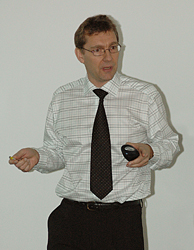The introductory course was designed for professional engineers and researchers to provide them with a better understanding of the procedures involved in the analysis and design of structural members subjected to large dynamic loadings produced by explosions and impacts. The treatment of the subject was largely based on simplified methods and design data from widely used design manuals for blast resistant design and applies to structural crashworthiness, explosion mitigation, hazard assessment and safety calculations throughout the civil, mechanical, nuclear, transportation, petrochemical and process industries.
Over a period of 2½ days lectures were presented on the following topics:
- Introduction and general considerations
- Quasi-static approximation
- Elementary impact and stress wave considerations
- Energy-absorbing systems
- Human impact injury criteria
- Structural crashworthiness
- Failure and perforation
- Blast loading determination
- Dynamic material properties and response criteria
- Principles of structural dynamics and SDOF analysis methods
- Blast response of ductile and non-ductile structures
- Case studies
The advanced level course was aimed primarily at engineers and researchers who were already familiar with the basic principles of structural dynamics and material response at high rates of loading but wished to progress their knowledge to more complex structural systems such as composites, sandwich structures and sacrificial-cladding systems.

Over a period of 2 days lectures were presented on the following topics:
- Introduction
- Dynamic properties of high-strength ductile materials
- Energy-absorbing and sacrificial-cladding systems
- Sandwich structures
- Dynamic buckling of structures
- Scaling and experimentation
- MDOF analysis methods
- FEA methods
- Impact of composite structures
- Case studies
Both courses were well attended by participants from many different countries.
 Professor Norman Jones, recently retired as AA Griffith Professor of Mechanical Engineering and Director of the Impact Research Centre at the University of Liverpool, has conducted theoretical, numerical and experimental studies over the past 40 years into the dynamic behaviour of structures and systems. These studies have clarified the influence of material strain rate sensitivity, transverse shear forces, finite deflection effects, failure criteria, rotatory inertia and other phenomena on the response of a wide range of structural members subjected to impulsive, dynamic and impact loads causing large inelastic deformations.
Professor Norman Jones, recently retired as AA Griffith Professor of Mechanical Engineering and Director of the Impact Research Centre at the University of Liverpool, has conducted theoretical, numerical and experimental studies over the past 40 years into the dynamic behaviour of structures and systems. These studies have clarified the influence of material strain rate sensitivity, transverse shear forces, finite deflection effects, failure criteria, rotatory inertia and other phenomena on the response of a wide range of structural members subjected to impulsive, dynamic and impact loads causing large inelastic deformations.
Professor Jones is Editor-in-Chief of the International Journal of Impact Engineering, Associate Editor of the Applied Mechanics Reviews, US and the Latin American Journal of Solids and Structures, and is on the editorial boards of several other international journals.
He wrote the book ‘Structural Impact’ and has co-edited nine other books, as well as publishing nearly 300 journal articles. He has won two prizes from the Institution of Mechanical Engineers, another from the Royal Institution of Naval Architects, an Eminent Scientist Award from the Wessex Institute of Technology, and has been invited to serve on many international conference committees as well as delivering plenary and opening addresses. He was elected to the Royal Academy of Engineering in 1998 and a Foreign Fellow of the Indian National Academy of Engineering in 2005 and has honorary professorships for two Chinese universities.
 Dr Graham Schleyer is a Senior Lecturer in the Department of Engineering and a member of the Impact Research Centre at the University of Liverpool. His current research interests lie in advancing the understanding of blast and impact performance of new and innovative structural materials and systems through sub-scale testing and computer simulation. Dr Schleyer is secretary of the UK Explosion Liaison Group (UKELG), and is also a member of the International Scientific Advisory Committee of the International Conference on ‘Structures under Shock and Impact’ organised by the Wessex Institute of Technology.
Dr Graham Schleyer is a Senior Lecturer in the Department of Engineering and a member of the Impact Research Centre at the University of Liverpool. His current research interests lie in advancing the understanding of blast and impact performance of new and innovative structural materials and systems through sub-scale testing and computer simulation. Dr Schleyer is secretary of the UK Explosion Liaison Group (UKELG), and is also a member of the International Scientific Advisory Committee of the International Conference on ‘Structures under Shock and Impact’ organised by the Wessex Institute of Technology.
Dr Schleyer is a Global Research Award holder (formerly Engineering Foresight Awards, Royal Academy of Engineering), which has enabled him to work with leading research and technology organisations in the US involved in the damage assessment of buildings under explosive shock loading, and ballistic impact testing and evaluation of protective structures.
During 2005 he was invited to speak at the Institute of Nanotechnology Seminar on Advanced Technologies in Crime Prevention and Detection at the Royal Society, and the Crime Science Network Seminar in the UK as well as the DYMAT Technical Meeting in Brussels. He has authored over 75 articles and reports submitted to journals, conferences, government organisations and industry.

 Wessex Institute
Wessex Institute